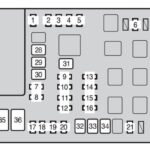For enthusiasts of the 1996 Ford Mustang looking to tap into their vehicle’s onboard diagnostics (OBD2) for performance metrics like torque, it’s crucial to understand the system’s capabilities and limitations. Having spent over six years exploring web resources and working with Ford tuning system developers, I’ve gained considerable insight into OBD2 data logging, particularly concerning older systems like those found in the 1996 Mustang.
While technologies like Bluetooth offer wireless connectivity, they aren’t ideally suited for reliable OBD2 telemetry. Their design wasn’t originally intended for the continuous data stream required for accurate engine monitoring. Although I once experimented with an ELM327-based Bluetooth data logger using robust industrial interfaces, the experience highlighted the inherent limitations of Bluetooth for this application. Range wasn’t an issue, but data reliability and speed were less than optimal for detailed performance analysis.
The 1996 Mustang utilizes Ford’s EEC-V engine control unit (ECU). A key factor affecting OBD2 data logging speed in these vehicles is the J1850 PWM communication bus, which operates at a relatively slow 41.6 kBaud. Furthermore, the EEC-V’s main processor operates at a modest 18 MHz. This processing power must handle critical engine management tasks – fuel and timing control, emissions monitoring, and communication with other modules like ABS and airbags – alongside responding to diagnostic requests. Consequently, OBD2 PID (Parameter ID) requests are processed only when the system has spare processing capacity, resulting in inherently sluggish data retrieval, especially when trying to monitor parameters relevant to torque calculation in real-time.
It’s also important to note that the sensors within the 1996 Mustang’s engine system, such as temperature sensors and even the Mass Air Flow (MAF) sensor, are not high-precision instruments. They are designed for repeatability and providing relative measurements sufficient for the Powertrain Control Module (PCM) to learn and adapt fuel and timing strategies. In closed-loop operation, which is the majority of driving for most users, the oxygen sensors provide feedback that allows the PCM to maintain the desired air-fuel ratio, even with sensor inaccuracies. This system is designed for robust average performance rather than highly precise individual readings.
The ELM327 chip is a popular and capable interface for OBD2 communication. However, even with an ELM327, data logging from a 1996 Mustang will still be constrained by the EEC-V system’s limitations. While modern vehicles with CAN bus systems and faster PCMs offer significantly improved OBD2 data rates, the 1996 Mustang’s architecture inherently limits the speed and responsiveness of OBD2 data, including parameters that could be used to infer torque. If considering an ELM327 device, ensure it utilizes a genuine ELM chip to avoid performance issues associated with clones, which often use older, less capable firmware.
In conclusion, while you can access OBD2 data from a 1996 Mustang for insights into engine operation, including parameters indirectly related to torque, be aware of the inherent limitations of the EEC-V system and J1850 PWM bus. The data logging experience will be slower compared to modern vehicles, and the sensor readings are designed for system control rather than high-precision torque measurement. For basic diagnostics and general engine health monitoring, OBD2 on a 1996 Mustang is useful, but for detailed, high-speed data acquisition for precise torque analysis, alternative methods or more modern vehicles might be necessary.

